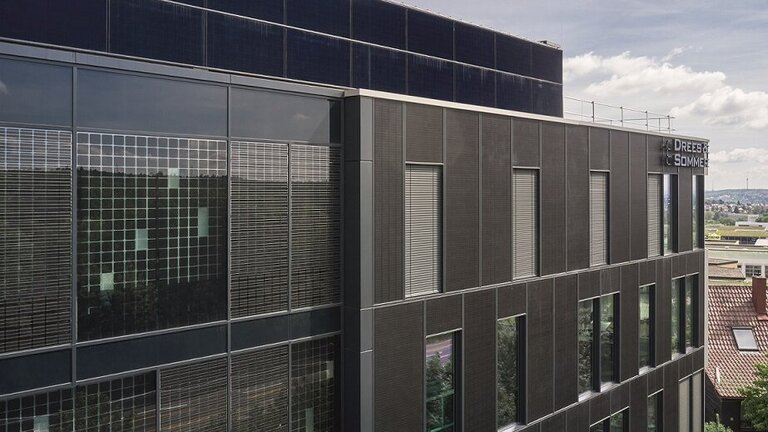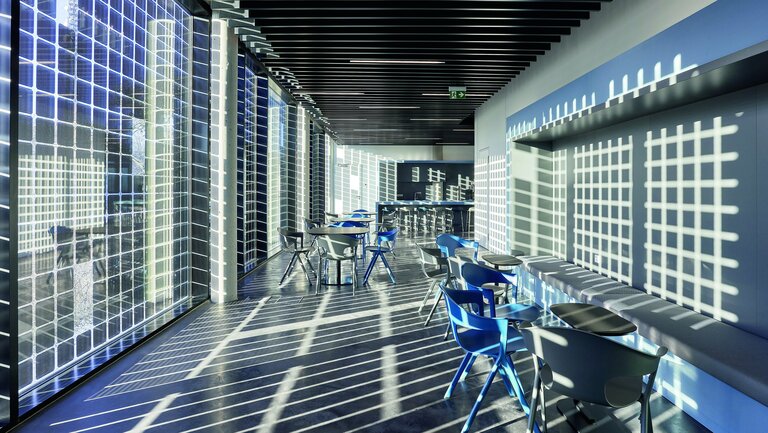Under German government plans, the share of energy consumption from solar sources is to be increased more than threefold by 2030. That will only be possible with the use of technological innovations – for instance photovoltaics (PV), the widespread use of which has long been possible with panels mountable not only on roofs but on building façades. However, the huge PV potential of façades is still not being exploited. The SolarEnvelopeCenter collaborative research project funded by the German Ministry for Economic Affairs and Climate Action aims to change this: under the leadership of Fraunhofer ISE in Freiburg, renowned industrial enterprises and research centers are currently working on standardized solutions for simple, quick and cost-effective integration of PV systems into building envelopes. On board is also the consultancy firm Drees & Sommer SE with headquarters in Stuttgart. The project started in January 2023 and is scheduled to be completed end of 2025.
Too expensive, too complex, not aesthetically appealing: the potential of solar modules on building façades is not being recognized. Christian Luft, energy management expert at Drees & Sommer said: “While it is possible to mount photovoltaic panels on any roof with relatively little effort or expense, conventional PV modules are generally unsuitable for façades. They can only be integrated with an unreasonable amount of technical effort and high costs.” The figures speak for themselves: “In order to achieve the target of 200 gigawatts of solar energy by 2030, we have to quadruple the installed PV capacity. Without photovoltaic façade systems, this cannot be done. The crux of the matter is that we currently lack the standardized planning tools to make the mounting of photovoltaic systems both technically practicable and cost-effective.”
Concentrated Expertise from All Market Segments
The aim of the SolarEnvelopeCenter research project and the network of industry and research partners involved is to change this. Work is currently in progress on the development of standardized solutions for the integration of PV systems into building envelopes. Dr. Helen Rose Wilson, who heads the project at Fraunhofer ISE, explained the targets of the research project: „Up to now, PV façades have mainly consisted of customized solutions involving a lot of hard work for all parties involved. Our research is intended to highlight practical solutions, some of which are standardized, that users can then combine and develop further according to the requirements of the project.”
Academic support for the project is being provided by the solar energy research institute Fraunhofer ISE and the Saarbrücken-based German Research Center for Artificial Intelligence (DFKI). Solar energy specialists and manufacturers are represented by the German section of the International Solar Energy Society (DGS), and the photovoltaic systems provider IBC SOLAR. The role of the architectural firm wulf architekten and the real estate consulting firm Drees & Sommer, both headquartered in Stuttgart, is to ensure that the standards developed can be applied in practice in the construction industry.
More Than an Attractive Façade: First Examples of Use in Construction Practice
How photovoltaic modules can be successfully integrated into building façades is demonstrated by flagship projects, such as the city hall of Freiburg and the OWP 23 office building in Stuttgart. Around 800 photovoltaic modules on the façade and roof of Freiburg’s city hall, which was completed in 2017, ensure that the building generates more energy than it uses. Drees & Sommer’s new office building, OWP 12 in Stuttgart, was also designed as a plus-energy building. In addition to solar systems on the roof, the innovative façade with PV panels on the south and west-facing sides provides sufficient green electricity to meet around a third of the building’s electricity needs. A total output of around 70 megawatt hours per year is produced by almost 700 square meters of façade area.
Thanks to the innovative façade construction, which meets very high standards of soundproofing and thermal insulation, the façade combined with the PV panels is only 210 millimeters thick. In terms of their visual impact, the integrated PV panels also provide an aesthetically pleasing solution.
Considering All Options
Drees & Sommer’s expert for energy management, Kai Babetzki, who will work on the research project together with Christian Luft in the coming years, added: “While solar systems on roofs are more efficient, it definitely pays to invest in photovoltaic systems on façades also. The two projects are the best example of this. If you want to build in a climate-neutral, future-proof way, you have to consider all options.” Their team colleague Valentin Balog, Drees & Sommer’s façades specialist, points out further benefits of photovoltaic systems on building shells: “Building-integrated PV systems are truly multitalented. Properly deployed, they not only generate electricity, but can provide a noise barrier, protect against extreme weather conditions, and regulate the building’s indoor climate.”
The SolarEnvelopeCenter research project is scheduled to be completed in two years. Plans are afoot to publish some of the findings of the research in a guideline from the German Association of Engineers (VDI) to stimulate widespread use and accelerate the integration of photovoltaics into building envelopes.
Opportunity for Discussion at the Building Integrated Photovoltaics (BIPV) Forum
The SolarEnvelopeCenter consortium will appear together in public for the first time at the BIPV Forum in Bad Staffelstein in Germany on February 28, 2024. In roundtable discussions and at the poster presentation, consortium members want to engage other participants at the PV symposium in a dialog about the idea of the SolarEnvelopeCenter project and the practicability of the solutions. The issues addressed will include the adaptation of PV modules for use in BIPV systems, and methods for calculating the cost effectiveness of these systems.
For more information (in German) about the event, please click on the following link: BIPV-Forum

